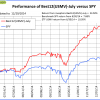Knowing when the U.S. Economy is heading for recession is paramount for successful investment decisions. Our weekly Business Cycle Index (BCI) would have provided early reliably warnings for the past seven recessions.
Read more >
Blog Archives
Business Cycle Index: A new high for February 19, 2014
Business Cycle Index: A new high for February 12, 2014
Knowing when the U.S. Economy is heading for recession is paramount for successful investment decisions. Our weekly Business Cycle Index (BCI) would have provided early reliably warnings for the past seven recessions.
Read more >
The Unemployment Rate is Not Signaling a Recession: Update February 6, 2015
A reliable source for recession forecasting is the unemployment rate, which can provide signals for the beginnings and ends of recessions. The unemployment rate model (article link), updated with the January figure of 5.7%, does not signal a recession now.
Read more >
The BCI Does Not Signal a Recession: Update February 5, 2014
Knowing when the U.S. Economy is heading for recession is paramount for successful investment decisions. Our weekly Business Cycle Index (BCI) would have provided early reliably warnings for the past seven recessions.
Read more >
The BCI Does Not Signal a Recession: Update January 29, 2014
Knowing when the U.S. Economy is heading for recession is paramount for successful investment decisions. Our weekly Business Cycle Index (BCI) would have provided early reliably warnings for the past seven recessions.
Read more >
The BCI Does Not Signal a Recession: Update January 22, 2014
Knowing when the U.S. Economy is heading for recession is paramount for successful investment decisions. Our weekly Business Cycle Index (BCI) would have provided early reliably warnings for the past seven recessions. The BCI at 183.7 is down from last week’s 184.0. No recession is signaled by both the derived indicators; BCIg, at 16.9 is down from last week’s 17.7, and BCIp at 81.6 indicates that, for this business cycle, BCI is slightly down from its previous peak.
Read more >
The BCI Does Not Signal a Recession: Update January 15, 2014
Knowing when the U.S. Economy is heading for recession is paramount for successful investment decisions. Our weekly Business Cycle Index (BCI) would have provided early reliably warnings for the past seven recessions. The BCI at 184.06 is near last week’s downward revised 184.05. No recession is signaled by both the derived indicators; BCIg, at 17.7 is down from last week’s 18.2, and BCIp at 85.2 indicates that, for this business cycle, BCI is slightly down from its previous peak.
Read more >
The Unemployment Rate is Not Signaling a Recession: Update January 9, 2015
A reliable source for recession forecasting is the unemployment rate, which can provide signals for the beginnings and ends of recessions. The unemployment rate model (article link), updated with the December figure of 5.6%, does not signal a recession now.
Read more >
A Falling BCI Does Not Signal a Recession: Update January 8, 2014
Knowing when the U.S. Economy is heading for recession is paramount for successful investment decisions. Our weekly Business Cycle Index (BCI) would have provided early reliably warnings for the past seven recessions. The BCI at 184.1 is down from last week’s 185.4. No recession is signaled by both the derived indicators; BCIg, expressed to one decimal place at 18.1 is down from last week’s 18.6, and BCIp at 86.6 indicates that, for this business cycle, BCI is slightly down from its previous peak.
Read more >
Minimum Volatility Stocks: Out-Of-Sample Performance of iM’s Best12(USMV) Buy&Hold Models

The backtest reported in this article showed that ranking the holdings of USMV, the iShares MSCI USA Minimum Volatility ETF, and selecting a portfolio of the 12 top ranked stocks, provided higher returns for the buy&hold portfolio than for the underlying ETF. To test these findings out-of-sample we launched the Best12(USMV)-July-2014on Jun-30-2014 and the first sister model Best12(USMV)-Oct-2014 on Sep-29-2014. Holdings and performance have been published weekly on our website since then. So far to Dec-15-2014 these portfolios have gained 19.2% (6.8%) and 10.5% (5.3%), respectively. (USMV gains are in brackets.) The test will be expanded by the launch on Jan-5-2015 of the second of the three sister models quarterly displaced, the Best12(USMV)-Jan-2015, which again will consist of the 12 highest ranked stocks of the then point-in-time holdings of USMV.
Read more >
